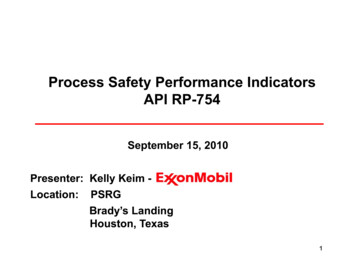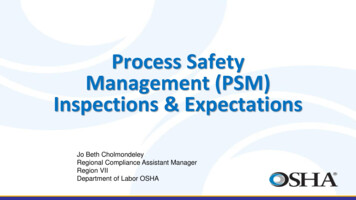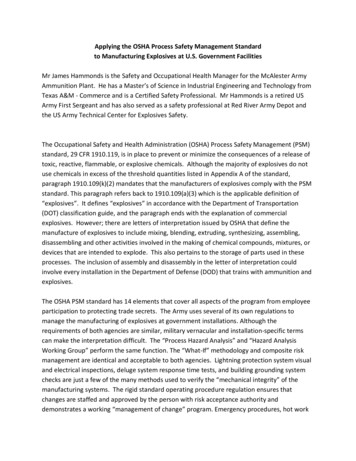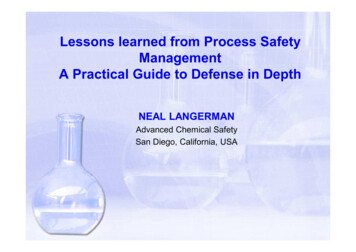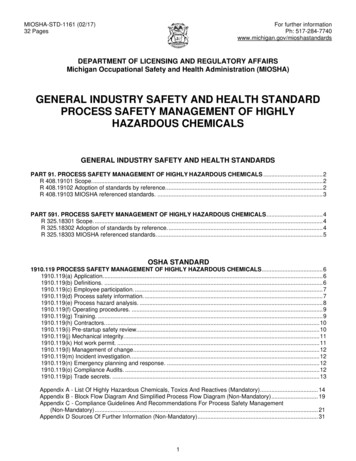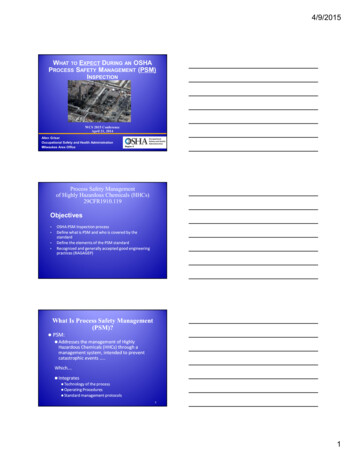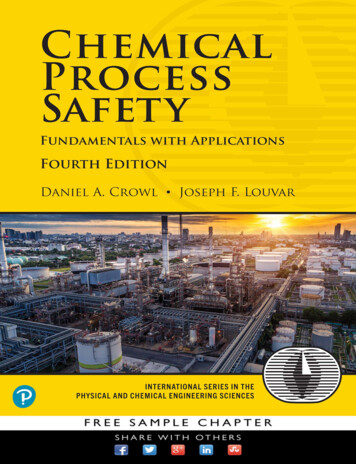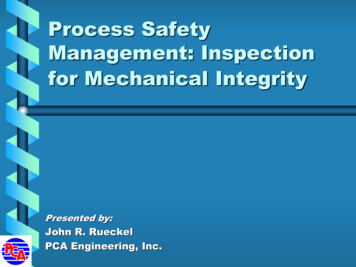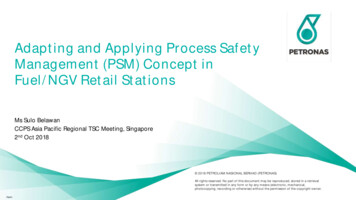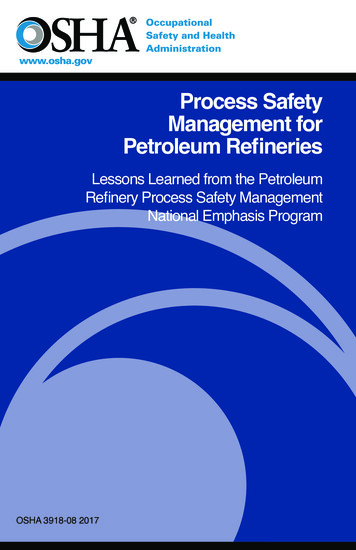
Transcription
INTERNATIONAL JOURNAL OF ENGINEERING TECHNOLOGY AND SCIENCES (IJETS) Vol.8 (1) Dec 2017DOI: http://dx.doi.org/10.15282/ijets.8.2017.1.10.1085A Journey of Process Safety Management Program for Process Industry1HanidaAbdul Aziz and 2Azmi Mohd Shariff1Occupational Safety and Health, Faculty of Engineering Technology, Universiti Malaysia Pahang, 26300Kuantan, Pahang, Malaysia2Centre of Advanced Process Safety, Department of Chemical Engineering, Universiti TeknologiPETRONAS, 32610 Seri Iskandar, Perak1hanidaaziz@ump.edu.myAbstract- The growth of process industries and global economies are dependent on technologyadvances and innovations. However, the effects of these advancements often lead to more complexprocesses and comparatively severe operating conditions such as high pressure, temperature andreactive chemical with exotic chemistry. With the rapidly increasing scale and complexity of theprocess, it is becoming harder to control accidents in process plants. In most of the past situations, itappears that accidents could not be controlled solely by engineering practices and traditionaloccupational safety but should be immersed with safety management programs specifically ProcessSafety Management (PSM) to enhance the effectiveness of technical solutions. This paper addressedPSM program as stipulated by OSHA 29 CFR 1910.119. The PSM standard was implemented followinga number of disasters, including accidents in Bhopal, India (1984) and Pasadena, Texas (1989). InMalaysia, Control of Industrial Major Accident Hazards (CIMAH) 1996 Regulation which has therequirements attribute to PSM standard also discussed.Index Terms- Process Safety Management, Risk Management Program, Process safety, Safetymanagement system, Process IndustryI.INTRODUCTIONSafety management programs are recognized and accepted worldwide as best-practice methods formanaging risk. This need is based on the understanding that once a risk is accepted, it does not go away;it is there waiting to happen unless the management system actively monitors the company operationsfor concerns and taking proactive actions to correct potential problems [1-2]. Having an effectivemanagement system for process-related hazards (fire, explosion, release of toxic materials, etc.) istherefore a critical corporate objective in the process industries. An approach widely used in the processindustries is Process Safety Management (PSM) program.PSM is the application of management principles to identify, understand and control hazards whilepreventing process-related injuries and accidents. PSM focused on prevention of, preparedness for,mitigation of, response to, and restoration from catastrophic release of chemicals or energy [3]. PSMentails development and implementation of program or system to ensure that the practices andequipment used in hazardous processes are adequate and maintained appropriately. It requires on-goingeffort to prevent catastrophic accidents involving hazardous process materials and energy. The PSMimplementation provided better impacts on safety of process industries such as fatality, injury and nearmiss were decreased, quality and productivity were improved, technical data were well reorganized, thenumber of emergency shutdown cases was decreased, the property damage was reduced, and theproblem of reinsurance was solved [4].1
INTERNATIONAL JOURNAL OF ENGINEERING TECHNOLOGY AND SCIENCES (IJETS) Vol.8 (1) Dec 2017DOI: I.PROCESS SAFETY MANAGEMENT OF OSHAThe US Occupational Safety and Health Administration (OSHA), which was created in 1970, began itsfirst major efforts in chemical process safety in the early 1980s following several catastrophic events,as shown in Figure 1. This timeline illustrates process safety history in relation to major OSHA processsafety milestones. A release of Methyl Iso-Cyanate (MIC) at Bhopal (1984) and methylchloride at WVfacility have prompted OSHA to inspect all US facilities that produced MIC. The inspection UnionCarbide led OSHA to believe that it needed to look beyond its then current standards and look atmanagement systems, work practices, and protective systems [5-6].Soon after the MIC and Union Carbide Inspections were completed, OSHA began a specialemphasis program aimed at chemical manufacturers. The purpose of this Chemical Special EmphasisProgram (Chemical SEP) was to determine industry practices for the prevention and mitigation ofcatastrophic chemical releases, and to determine how OSHA could protect chemical industry workerswithin its legal authorities, resources, and policies. The Chemical SEP lasted from January 1986 untilSeptember 1986, and targeted manufacturers of high hazard substances. During the inspections,Compliance Officers reviewed programs rather than focusing only on physical conditions. OSHArealized that many of its standards at the time may not cover the numerous hazards found in chemicalplants, and encouraged Compliance Officers to look for industry standards that applied to thosehazardous conditions [5].Figure 1: OSHA PSM Timeline [5]Following the Chemical SEP, several more catastrophic accidents occurred. On July 17, 1990,OSHA through Federal Register (55 FR 29150) documentation, proposed a standard entitled “ProcessSafety Management of Highly Hazardous Chemicals”. This standard list the requirements for themanagement of hazards associated with processes using highly hazardous chemicals. This is toencourage a safe and to help assure safe and healthful workplaces. The notice of proposed rulemakinginvited comments on any aspect of the proposed standard. OSHA received more than 175 comments inresponse to the notice of proposed rulemaking. In addition to these comments, the hearings resulted inalmost 4,000 pages of testimony and almost 60 post-hearing comments and briefs. In November 1990,Congress passed the Clean Air Amendments of 1990 mandating that OSHA promulgate a rule onchemical process safety. In February, 1992 PSM is regulated through the PSM standard, 29 CFR1910.119, titled Process Safety Management of Highly Hazardous Chemicals [5-7].The standard mainly applies to manufacturing industries particularly, those pertaining to chemicals,transportation equipment, and fabricated metal products. It also applies to pyrotechnics and explosivesmanufacturers covered under other OSHA rules and has special provisions for contractors working incovered facilities. In each industry, PSM applies to those companies that deal with any of more than130 specific toxic and reactive chemicals in listed quantities (Appendix B of PSM 29 CFR 1910.119),it also includes flammable liquids and gases in quantities of 10,000 pounds (4,535.9 Kg) or more [7].2
INTERNATIONAL JOURNAL OF ENGINEERING TECHNOLOGY AND SCIENCES (IJETS) Vol.8 (1) Dec 2017DOI: SM of OSHA comprises of 14 elements that are used to manage facilities, technology, andpersonnel as summarized in Table 1 Prior to the implementation of the PSM standard, OSHA predictedthe impact of this rule. OSHA also anticipated about 24,939 establishments that could be covered,including 127 industry subgroups and three million employees including contractors. The standard wasexpected to prevent 132 deaths and 767 serious illnesses and injuries in the first five years, and twicethat by the second five years [5-6]. It is also believed that, the OSHA PSM regulation has excellentrequirements that could and should prevent casualties if plants follow the regulation as intended [8-9].Table 1: Overview of OSHA PSM Element [7]PSM ELEMENTDESCRIPTIONEmployeeParticipationProcess SafetyInformationEnsure that workers and their representatives are consulted and have access toinformation regarding all PSM elements.Maintain complete and accurate information on the process technology, processequipment, and hazardous characteristics and physical properties of all chemicalsand intermediates for all covered processes.Identify and assess process hazards for each covered process, and take action tomanage risk.Provide clear written instructions for safely conducting activities at each coveredprocess that address operating limits, safety and health considerations, and safetysystems and their functions.Provide initial and refresher training with a means of verifying employeeunderstanding for all employees involved in operating a covered process.Ensure that subcontractor operations do not compromise the level of safety on or inthe vicinity of a process using Highly Hazardous Chemicals (HHCs).Perform safety reviews for new and modified facilities prior to operation when themodification is significant enough to require a change in the process safetyinformationEnsure the integrity and safe operation of process equipment through inspection,testing, preventive maintenance, and quality assurance.Ensure that appropriate measure is take in any time non routine works, specificallyhot work such as welding operations are performed on or near covered process areasthat might introduce the potential for increased risks of fires and explosion.Establish and implement written procedures to manage changes (except forreplacements in kind) to process chemicals, technology, equipment, and procedures,and to facilities that affect a covered processUsing a written procedure, provide a team investigation of any incident which resultsin, or could reasonably result in, a catastrophic release of a highly hazardous chemical.Each investigation must be documented in a written report and findings andrecommendations resolved in a timely manner.Establish and implement an emergency action plan for the entire plant that is incompliance with 29 CFR 1910.38(a) and that also addresses small releasesEnsure that the PSM program is operating in an integrated and effective manner incompliance with PSM requirements.Ensure all information is available to support the PSM Rule. When necessary,confidentiality or nondisclosure agreements may be used.Process HazardAnalysisOperating ProceduresTrainingContractorPre-Startup SafetyReviewMechanical IntegrityHot Work PermitManagement ofChangeIncident InvestigationEmergency Planningand ResponseCompliance AuditsTrade SecretFull implementation of the PSM work process should also include a systematic approach inmanaging the PSM process and activities. The process requires that the program can ensure continuitywhen personnel change, and to include quality assurance such as steps to plan, implement, check, andcorrect the PSM implementation program. Work process failures should be addressed by improvementof documentation already in place, promptly resolving PSM-related recommendations of all types, and3
INTERNATIONAL JOURNAL OF ENGINEERING TECHNOLOGY AND SCIENCES (IJETS) Vol.8 (1) Dec 2017DOI: eeping track of the ever-changing Recognized And Generally Accepted Good Engineering Practices(RAGAGEP) that applies to many aspects of the PSM program. In addition, it is essential to getmanagement support/involvement and to establish follow-up systems to ensure all work activities arecomplete and adequately documented. Instituting complete work processes will improve the PSMprogram, its efficiency, and help reduce the chance of citations [4].III.RISK MANAGEMENT PROGRAM 40 CFR 68The other accident prevention program contained in the amended Clean Air Act (CAA) (1990) calledfor EPA to develop regulations to prevent and respond to chemical accidents that could affect the publicand environment off-site. EPA met this obligation in 1996 by promulgating the Risk ManagementProgram (RMP) regulations (40 CFR 68) [10]. EPA is extending PSM requirements with the proposedRMP. The RMP focuses on reducing chemical incident risk at the local level, to aid emergencyresponders in developing strategic preparedness and response plan and to educate the general publicabout chemical hazards. The RMP is similar to OSHA’s PSM standard, as it covers many of the sametoxic and flammable substances, and requires virtually the same set of accident prevention requirementsas the OSHA standard. However, while the accident prevention elements of PSM and RMP are nearlyidentical, EPA Risk Management Program contains several additional requirements beyond thosecontained in OSHA PSM. These include the following:a) Facilities must prepare a history of accidental releases occurring over the past five years.b) Facilities must perform an Offsite Consequence Analysis (OCA), which is an analytical estimate ofthe potential consequences of hypothetical worst case and alternative accidental release on the publicand environment around the facility.c) Facilities must submit a summary report, called a Risk Management Plan to the EPA. The plancontains the facility’s five-year accident history, a summary of its accidental release preventionprogram, its offsite consequence analysis, and a summary of its emergency response plan.d) EPA must make all Risk Management Plans available to state and local governments and the Public.IV.RISK-BASED PROCESS SAFETYThe American Institute of Chemical Engineer (AIChE) created the Center for Process Safety (CCPS)in 1985 to develop and disseminate technical information to be used in the prevention of major chemicalaccidents. CCPS has created Risk-based Process Safety (RBPS) and name it as framework for the nextgeneration of Process Safety Management (PSM). Figure 2 tabulates the elements of RBPS that havebeen built on a foundation of four pillars including commitment to process safety, understand hazardsand risk, manage risk and learn from experience [11]. These pillars are further divided into 20 elements.The 20 RBPS elements build and expand upon the original 12 elements proposed in the 1989 work. TheRBPS elements were meant to be evaluated by companies, which may then decide to implement someaspects of these elements, based on thoughtful consideration of their existing PSM systems. Companyspecific and
Safety Management of Highly Hazardous Chemicals”. This standard list the requirements for the management of hazards associated with processes using highly hazardous chemicals. This is to encourage a safe and to help assure safe and healthful workplaces. The notice of proposed rulemaking invited comments on any aspect of the proposed standard. OSHA received more than 175 comments
